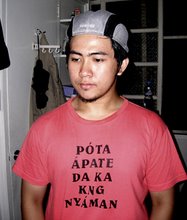I believe the measure of how godly someone can be comes with the ability to transform things into useful stuff like energy, a piece of art, a tool, food, source of income, etc.; to animate value in things which are otherwise static, boring, and useless if left alone without the tapping of humans.
From both scientific and occult perspective, energy is embedded in everything. However, if we remember our elementary science, energy comes in either potential state or kinetic state. A medium-sized rock planted still on the ground has potential energy; it has energy stored within its mass that can be turned into kinetic, if, say, one picks it up and throws it at the lousy contestant in an amateur singing contest. The potential energy of the rock, fused with the physical energy from the thrust of the arm in throwing the rock, is turned into kinetic.
Or something like that. I am no science expert. Plus, I'm too lazy to check my readings again and go down memory lane. Full of painful memories in elementary, like that time when my English teacher kept insisting to me that the word seize is pronounced saiz instead of seez and that time when our Filipino teacher banned the use of any form of Kapampangan verbal communication in her class. But you get what I mean anyway regarding energy.
With my latest re-realization regarding the god meter I was talking about, I realized yet another thing again: I have underestimated the godliness of a writer. I am in awe of this realization because it is too beautiful to not philosophize about. Consequently, it also gave me a confidence boost during these days I feel a bit low due to my almost-three-year-old frustration in acquiring my ideal body weight.
It's too beautiful that I cannot not use pamamoesya to express my latest finding. So, without further ado,
pagdamutan ye ing kanakung kawatasan a makipamagat a...Ing Upaya Ning TalasulatNung lalawen tamu king panimanman ning Apung Ginu
Ing upaya na ning nanu man makasalaleng tutu
King kagiwan nang taginan ing kaya makapalibut
At gawan na pang kapaki-pakinabang keti yatu
Anti mo ring keraklan karing balu tamung tanaman
Dirian dang silbi ing gabun, aslag ning aldo, at danum
Pati pangisnawang tau, nung kekatamu kamandag
Ila sisingapan dang malalam, karela e lasun
(If we put ourselves in the shoes of the Supreme BeingThe power of anything truthfully dependsOn its ability to wield everything that surrounds himMake them valuable and useful in this worldExempli gratia, most of the plants we knowThey give use to earth, sunlight, and waterEven the air we exhale even if poisonous to our lungsThey inhale deeply, to them it's not venom)King Gerona na mu pin ketang lalawigan ning Tarlac
Ating pipanganan karin, Isdaan ing kayang lagyu
Pánakitan da ing mua ring tau, karela mamayad
Para mamasibas platu kabang mánagkas taksiapu
Sukat mung ring kabalenan pati aliwalas diren
Dang pakinabang; espasyu mu ing karelang puhunan
Kukua lang abli karing bisang manyabit patalastas
‘Nya ring negosyanti pati espasyu pisasamsaman
(There in Gerona in the province of TarlacThere's a restaurant that goes by the name IsdaanThey earn money from the angst of people who payTo throw plates at a wall while cursing "taksiapu"Let's not forget the cities that make use of spaceMere space is their capital in this industryThey earn from people who wish to put up billboardsExplains why even businessmen fight over space)Dapot pangaratang naman karing tau keti sulip
Nung atin ku man yausan bukud iya pin ing talasulat
Pauli ning kayang upayang masakit apantayan
Nung pagisipan me ping malalam tutung makagulat
O ninu pa ta karing sablang mabibiye kening yatu
Makikagiwan dian pakinabang ing keganagana
Puhunan mu kabud kabiasnan king metung a amanu
Mapagumasid a pusu’t isip, papil ampong tinta
(But when it comes to humans here on earthIf there's someone most distinct, it'd be the writerFor his power seemingly unmatched by anyoneIf you'd think about it seriously, you'd be in for a surpriseO who among the human beings in this worldHas the ability to give value and use to everythingAll it takes is skill in a certain languageAn observant heart and mind, paper and ink)Ing metung a talasulat ding anggang árapan king biye
Mayumu man o mapait, mabanglu man o mabuluk
Mabakanti ya mu oras makalalang neng salese
Nung magaling ya pa, ay, agyu na kang awitan buntuk
Daptanan me mang karawakan, laraman meng maragul
Sapituan me mang masikan, ita ngan adian nang silbi
Ing anggang kapalpakan na manibat pa ‘nyang kebaitan
Ganakan na mung misan, makapanyulat na yang tambing
(Out of all that the writer encounters in his lifeMay they be sweet or bitter, fragrant or rancidHe can produce an artwork in his vacant timeAnd if he's really good, he can even enslave your headDo him harm, tell him a great lieSlap him hard, all of these he can turn usefulAll of his failures beginning from his birthOnce he decides to reminisce, he can already write)Nung bisyu na’ing miminum, pati ing pamipangunyuran
Ukuman ne man ning meto ketawan bilang salbahi
E bali; pangauli na, pantunanan na mung santing
Ing daraptan na at saka na ipoesya king papil
Kuentu ning kaluguran, saingsing ning kayang kasaman
Ing balita king radyu, pati katak nang Kris Aquino
Tipunan ngan king memorya’t idapuk king kamalayan
Lalangan na king MS Word pota nang misan a aldo
(Even if drinking is his vice, along with philanderingEven if society labels him an infernal personNo big deal; when he comes home, he'll find beautyIn the things he does and transmute them into poetryThe tale of a friend, the complaint of an enemyThe news on radio, including Kris Aquino's blabberAll of these he'll gather and store in his mindThen make use of them using MS Word one day)At potang ing realidad makasawa’t alang kule
Gamitan ing waga, mapaglalang a isip paganan
Migut inspirasyun pati king pantasyang agyang dirit
E mu isip-isipan malyari keti kapilan man
Akit mu pati ing ala agyu nang saksakanan biye
At makapatalakad ya pa ping yatu nang sarili
Karing nobela kontroladu na la ngan ding gaganap
Kalinangan a pinupul na ‘bat king kayang paligid
(When the time when reality's boring and colorless comesUse one's imagination, ignite one's creative mindDraw inspiration even from fantasy which not one bitCannot happen in real life, no sireeYou see, he can even give life to nothingnessHe can even erect his own worldIn novels he controls the lives of every characterSensibilities he harvested from his environment)E ya mu king mílabas malyaring manyaklung istorya
At ali ya rin king ngeni mu malyaring magumasid
Ding posibling maganap king bukas apakinabangnan
Nostradamus, Herbert Wells ding ditak a malyaring ‘sambit
Ing kesikan na pang upaya ning metung a susulat
Obra na makikagiwan yang mabiye kabang panaun
Ambuski pa mete ne ing mengudta atiu pa mu rin
Anting bining daragul ding kalalangan nang dinaun
(Not only from the past can he extract a storyAnd it is not only the contemporary he can observeEven the possibilities in the future he can wieldNostradamus, Herbert wells, to name a fewWhat makes the writer much more powerfulHis work has the ability to live through timeEven if the author is dead, still it livesHis art like a seed that grows as time passes by)At ngening panaun nung nu ing pamiyuyugnayan da
Ring marakal a sosyedad sisikan uli ning IT
Gawa ning talasulat aparala ne Amerika
Asable ne Internet anti ring dakal a MP3
At dening anggang kukudta ning metung a talasulat
Makikagiwan lang magpagalo isip da ring tau
Nung pati kiliti ring sablang mámasâ kayang balu
Agyu nong bayuan biye gamit ing masanting a amanu
(And in this period when the communicationbetween several communities is enhanced through ITA writer can send his work to AmericaHe can upload through the Internet like many MP3sAnd all the works of an authorHave the potential to influence the minds of the peopleIf he knows even the approach in attracting readersHe can change their lives using beautiful words)Ini ing upaya ning metung a biasang talasulat
Upayang masákit sukdan, upayang e ra tanggapan
Kalam a malyaring e balu ‘buski ning makitagle
Upayang king yatung ini e makaying papansinan
Ing kawatasan ku pung ini ing kayang pakinabang
Gisingan la kaladua ring kapara kung talasulat
Ipabalu ku karela ing tatalanan dang sikan
Gamitan da sang masalese para makapamulat
(This is the power of a skillful writerPower that is hard to measure, power they won't acceptA blessing that might not be known even to the ownerPower that in this world is often neglectedThis poem I wrote, this is its useWake up the souls of my fellow writersMake known to them the potential they holdMay they use their power well to wake up more people)























